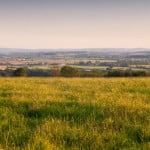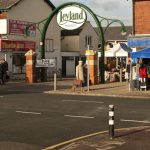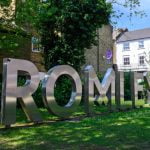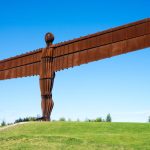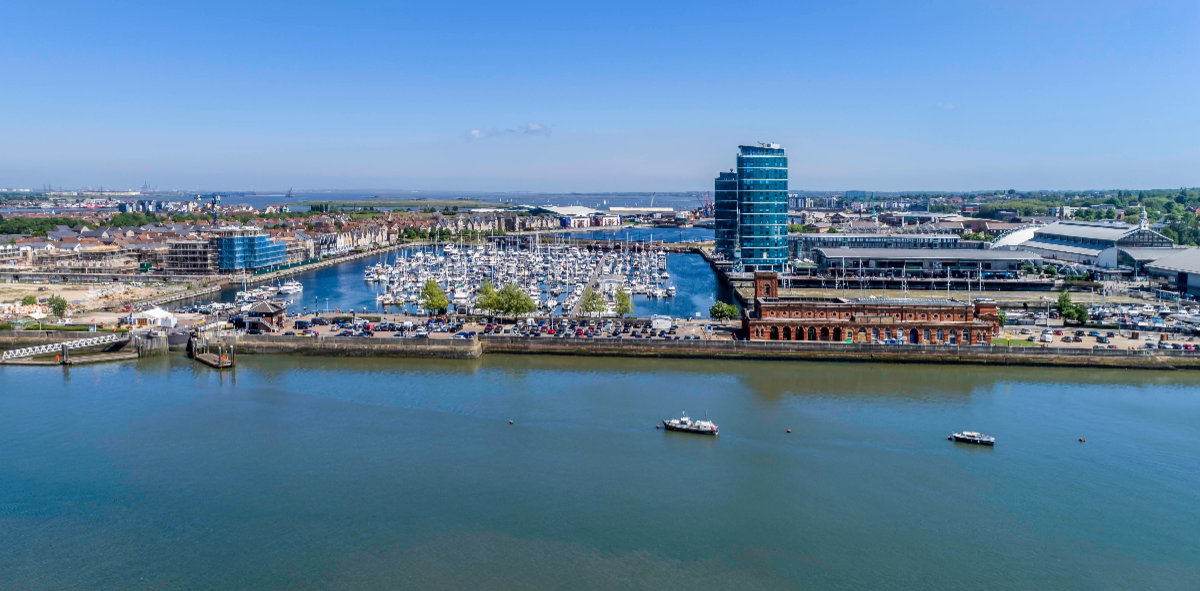
Take Five Minutes to Get to Know Gillingham the one in Kent, not the Dorset one.
An English town named after a Warlord…
…and not many English towns get to make that claim. It’s true! The historians think that Gillingham was named after a Warlord named Gyllingas. This is an Old English name which roughly meant ‘the one who shouts. We suppose anyone can be a leader if they shout loudly enough…
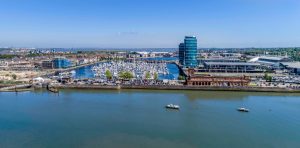
Image: Mark Dillen
Anyway, on to Gillingham.
Let’s take a look back through the history of this happy Kentish town, to see what we can learn about its roots before we go there on holiday. The staycation is in this year. Here at Five Minutes Spare we are determined to find the best places to visit before it’s too late.
Early Days of Gillingham
The less legendary saying has it that Gillingham is actually descended from Old English, and that the word ‘ham’ was a town devoted to the people of Gylla… who was indeed, a warlord. The time of the Warlords was around the same time as the Vikings roamed the land, so it is possible that Gylla was a Dane. What we do know is that the town was recorded in the Domesday Survey of 1086… twenty years after the invasion of William the Conqueror.
You see, William was a bit of a collector of… countries… and he wanted to know exactly what it was he had won, when he invaded England. The Domesday Book isn’t anything like what it sounds to be; instead of being a book about the end of the world, it is, in fact, a collection of all William the Conqueror’s new toys.
You can still read through this fascinating document to see if your town existed in 1086. Gillingham did. It was huge by the standards of ye olde England. It contained a Five Minutes Spare record of 69 houses – which makes it fairly remarkable. Many towns of a similar size were skipped entirely because they were assumed large enough that everyone knew about them. Gillingham wasn’t skipped because it belonged, for the most part, to the Archbishop of Canterbury.
The blessed Archbishop owned 42 villagers, 18 smallholders, 3 SLAVES, 15 ploughlands, 2 Lord’s plough teams, and 15 villager’s plough teams. He owned a church, a woodland large enough for wild pigs to roam, 14 acres of fields, a church, a mill, and three fisheries. So there you have it. Rumours about the former wealth of the church (before Henry VIII’s madness) were entirely true.
Asides from the Archbishop, the Bishop Odo of Bayeux was gifted the rest of Gillingham, probably due to service of, or relation to, the new king. He owned ploughland and teams, meadows, and forests – to the tune of 3 pounds a year annual income. Not much by comparison to the 25 pounds a year the Archbishop made.
All of these things should come together to give you an idea of what early Gillingham was like. It would have been a bustling town, interspersed with woodland and meadows, where hogs stole crops and people chased them with pitchforks, afraid of killing them in case the Archbishop caught them and punished them for poaching.
Moving on.
The Medieval Era Gillingham
In the 12th century, the Archbishop decided to build his palace in Gillingham. The palace took up 20 acres and was later one of Henry VIII’s greatest closures. Sometime in the 13th century, the Normans built Gillingham Parish Church. They dedicated it to Saint Mary Magdalene. It was upgraded in the 15th century to include a tower, presumably before Henry VIII got his grubby little hands on it.
Permission was granted for a town charter in the 14th century. these were documents from the king that allowed the town to become a town. A market was held weekly that would have drawn trade from all over the area. The success of the area saw a dockyard added, with the port becoming known as the Cinque Ports, but the actual port of Gillingham being included with nearby Chatham Dockyard. The port would have traded English goods like leather, meat, wool, and dye, all over the known world. The port was of international importance up until the 1940s when the Second World War put a stop to most trade on the east coast.
The Dutch Occupation
In 1667, a fleet of Dutch ships sailed right on up the River Medway’s entrance, unchallenged. As you can imagine, this caused some consternation in London and resulted in the Dutch occupying the Isle of Sheppey for a while. They occupied Gillingham during the attack but eventually retreated of pretty much their own accord. We did invade the Dutch first though, so it was kind of on us. You can read more about the “Raid on the Medway” an event that is regarded as the worst defeat in British Naval History.
The tail end of the medieval period saw the Seven Years’ War begin and the arming of the docks and river entry – which, let’s face it, should have been done in 1668. A gun battery was added, the dockyard peninsula protected, and the enemy didn’t get in. In 1778, another war with France saw more guns added, followed by even more guns placed on the walls in 1800. It was like a software update in those days. Always renew your guns every two years or they become obsolete.
The docks were expanded to incorporate all the guns, and the workers that built the guns, and finally the troops that manned the guns that the workers built. By 1851, there were 9,000 people living on top of/around the gun peninsula. They called it New Brompton. And that’s a good place to pause the history lesson and lighten things with a bit of trivia.
Delightful Gillingham Trivia
For those of you that really love – we mean really love – Gillingham, here are some of the Five Minute Spare trivia facts that you can use to delight your friends with. Get stuck in and amaze the group, with these savvy facts:
- There are two UK Gillingham’s this one and another in Dorset. The Kentish Gillingham is pronounced with a soft “G”, is much bigger, much older, and has sea access.
- Much of Gillingham was once owned by a single family, the Davenports. They lost control of the waterfront in 1889 – despite owning a 15,000-acre estate in Ashford.
- A Royal dockyard was established by Queen Elizabeth I in 1568 in neighboring Chatham. It was relocated in 1622 with most of it subsequently being within the Gillingham boundaries. It continued operations until 1984.
- Gillingham was technically one little town that swallowed up lots of big towns. Eventually, the amalgamation of settlements became known by one title. This is why the ‘suburbs’ of the town are so independent.
- The local football team Gillingham FC was formed as New Brompton FC back in 1893. They didn’t become Gillingham FC until 1913.
- There was an electric tram system in town from 1902 until 1930 when the busses took over.
- Gillingham has two twin towns – unusually both are from Japan. These being Ito and Yokosuka.
Don’t you feel better knowing that you can whip these facts out at parties, and never be stuck for a conversation again? We sure do.
On with the next few hundred years!
More Modern Times in Gillingham
Circa 1868, the architect Sir Arthur Blomfield restored the church to its former glory, bells, towers, and all. The train stations opened in 1858 but, due to government weirdness, was named New Brompton. It was later referred to as New Brompton (Gillingham) but ultimately went through a real name change in 1899.
The last tram ran from the Naval Barracks to Rainham Road in the year 1930, after three decades of service. It must have been a sad day for the operators. Between 1891 and 1901, the population grew by around 15 thousand people. The introduction of that railway really brought the crowds to the seaside, encouraging less industrial growth and more tourism.
In the First World War, Gillingham sent many young men to the trenches. The town itself is of strategic importance and had to be manned. The barracks nearby provided sailors and soldiers for the Naval Base, right up until 1984.
In 1929, the Gillingham Fire Brigade put on a show at the annual fair. Normally, they would conclude the celebration with a three story imitation house built out of cheap wood. The fire brigade’s trainees were then invited to put on a bit of a show. They would imitate a house party, with some upstairs and some downstairs. A fake fire would start in the house by way of flares and sparklers. Later, the firemen would make a show of rescuing the party-goers, then set a real fire which they could put out. Someone lit the fire too early and the trainees actually had a real fire to deal with.
A horrifying account of the accident contains details of how the audience cheered and clapped as the house burned down. They thought it was part of the show. It was only after some burning bodies jumped to their deaths from the upper floors that they realised what was wrong. Although the fire brigade managed to save two of the 15 people in the wreckage, they both succumbed to their injuries later, in hospital. 13 other men and young boys died at the scene.
WWII Hits Gillinghm Hard
There was, arguably, only one incident that was worse for Gillingham than the Fire Brigade Disaster… and that was WWII. Kent was bombed excessively, being nearest to London. Some German pilots would drop their bombs here because it was outside of the city of London and they thought they were being kinder… the truth is that the Kent Blitz was almost as bad as that experienced in London as a result. The River Medway was guarded right into the ’40s, with enemy ships patrolling offshore.
Warships would have bombed the shore when they got close enough, U-boats were likely to have joined in. The Schools in the area were evacuated, with some kids being sent to Sandwich to keep them safe. WWII in Gillingham was not a nice place… it wasn’t a nice time period anywhere.
In 1951, the Gillingham Bus Disaster saw a double-decker bus plow into a company of 52 young volunteers for the Cadet Corps. 24 cadets between 9 and 14 years old were killed in one horrific incident. It will never be forgotten for as long as the town exists.
Modern Gillingham
Gillingham had been quite reliant on the naval base employment-wise and the town was hit hard after it closed in 1984. Fortunately, the Gillingham Business Park was established in its wake and this is now one of the most popular business destinations in the region, thanks to its close proximity to both the town centre and the M2 motorway. Tourism and shopping are also big parts of the local economy with Gillingham Marina being a popular attraction. Gillingham is an important retail centre serving a substantial part of Medway and of course, it still has its historic street market which is a must-visit if you are in town on a Monday or Saturday.
Famous People from Gillingham
Everywhere in the country has a list of famous faces attached. No matter where you go, you can be sure that there is a wealth of famous people from that area – especially if it is in the UK. Here are some of the Five Minutes Spare favourite famous people from Gillingham:
- Hundreds of footballers like Ronald Baird, Jack Beby and Luis Binks.
- Several cricketers, too, including John Dye, John Atchinson and George Blackmore.
- John Hartnell, who you don’t know, but who was first to die in the fated voyage to find the north passage,
- Sculpture Rick Kirkby is from Gillingham.
- The commentator Brian Moore was from Gillingham.
- Rik Waller, from Pop Idol, is a singer from Gillingham
As you can see, Gillingham in Kent has given more than its fair share of famous people for us to choose from. Now that we have that out of the way, let’s find out what other great attractions are there in Gillingham?
Things to do in Gillingham
Finally – we reached the part we all love the most. What is there to see and do in Gillingham? Should we make a point of visiting or should we avoid it like the proverbial plague? Let’s find out!
Historical Sights and Landmarks
One of the most obvious landmarks in the area is the Great Lines Heritage Park. This stretches throughout all of the gun batteries on the peninsula and covers other towns, too. You can go walk it and keep an eye out for the WWI monolith, which is a white landmark that towers above all else. The monolith is called the Chatham Naval Memorial, although it is technically in the Gillingham area.
Visit the Medway Queen for a semi-landmark, semi-museum experience. This docked ship lets you experience the world of military life at sea, all without getting your feet wet. Check it out down in the dockyard and be sure to invite the kids because they love the idea of being on a boat.
Museums and Galleries
Gillingham is where the engineers that powered the industrial revolution were trained. There is a Royal Engineers Museum that you can go and visit, that records and charts their progress. It makes for a really interesting afternoon out, and there are usually school groups attending. This location is known for being one of the largest military museums in Kent.
Outdoor Attractions
The Riverside Country Park is the top listed attraction in the area, according to Trip Advisor. This place incorporates nature walks with a kiddies play area, as well as a river, some sunbathing spots, and a café. It’s a great place to take the little ones for an afternoon in Gillingham.
The Capstone Farm Country Park is another place people love to go at the weekends. They have a café that is open until four and plenty of outdoor space for sports, hobbies, or just a bit of nature spotting. The park is gated and opens at 8 am. They do tend to shut it in the event of murder hornets and pandemics, so you have been warned. It might be better to call ahead, given the current global climate.
Sports and Recreation
Everyone, young and old, enjoys a trip to the Strand leisure park. This is a famous swimming area that has been known to serve the people of Kent since the Victorian era. Public baths have always been an important part of British life, all the way back to the Roman invasion in about 40 AD. The Strand is an ongoing tradition loved by all and should be at the top of your list of places to go and see in Gillingham.
Unlike the normal sports on offer, Chatham Ski and Snowboarding centre lets you get a taste of the great outdoors, while safely inside a dry slope. Get a glimpse of true skiing and snowboarding without half as much danger… it’s a perfect present for those of an athletic nature, too. To add to your choice of frozen treats, there is a Planet Ice in Gillingham. This is a large ice rink that sometimes sees ice hockey played on it, but which is mostly for the little ones to entertain themselves with on the weekends.
Let’s not forget the sport that put Gillingham on the map. Gillingham Football Club plays at Priestfield Stadium, which is simultaneously a stadium and a landmark to the town. Be sure to get the full tour or to catch a game.
Shopping and Retail
For the best shopping in town, the Hempstead Shopping Centre is an absolute must. You can check out all the shops you want to, making it an excellent place to get groceries or some new clothes. You can usually find loads of kids hanging around here at the weekends, too.
Other Notable Attractions?
That’s not all that you will find if you take your holiday in Gillingham. The town is so filled with things to do that we couldn’t even detail them all. To this end, we added in some of the other best bits of Gillingham, right here. Try some of these on for size…
- Don’t forget about Gillingham Golf Club. If you are in town for a while, then make sure you have a putt.
- The Twydall Community Centre sometimes runs its own shows or community events you can join in with.
- Splashes Sports Centre is yet another swimming pool in town, or you can head over to Medway Park.
- The Soar Trampoline Park is ready and waiting for you to have a bounce!
If you feel that there is a lack of things to do in Gillingham, then you probably just haven’t looked hard enough. If you are still stuck, ask one of the locals and see what they say.
How to get there?
And now you are in possession of the same information regarding Gillingham as we are. Whether this serves you well or not, remains to be seen. If you want to go there to check out your newly found data, this is how you can reach it…
By Road
Head out of London on the M2 and follow it until you hit Chatham. Gillingham is the other side of it.
By Rail
Gillingham (Kent) is on the South Eastern Railway Line. Be aware that there is a smaller Gillingham in Dorset that will take you far, far, far from where you are trying to go.
By Air
The nearest airport is Southend Airport, although London City is only 20 miles or so away.
By Sea
Gillingham features the Medway Ports and the Rainham Dock if you want to stop your boat there.
Still, Searching for a Staycation Destination?
If Gillingham isn’t the perfect dream staycation destination for you, then we can still help! There are a hundred other staycation destinations over on our webpages, ready and waiting for you to get stuck in to. We also have some travel locations overseas too, should the airports open up again.

